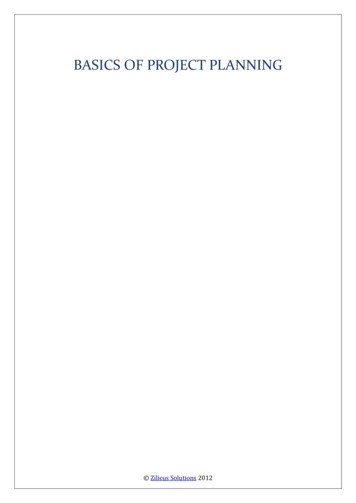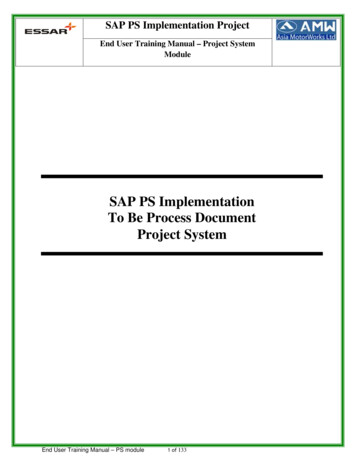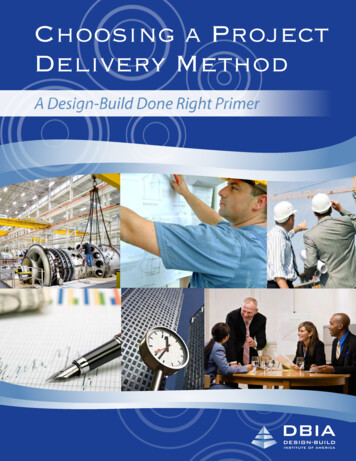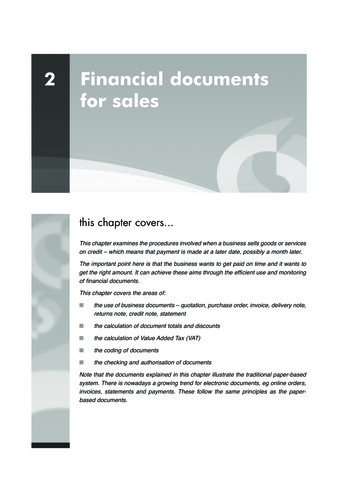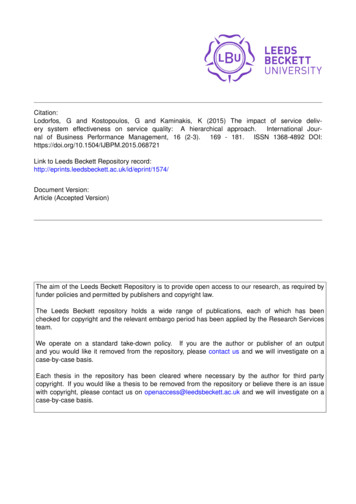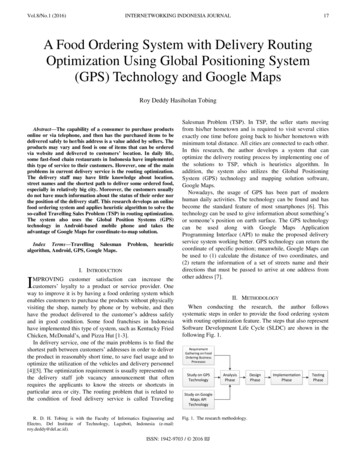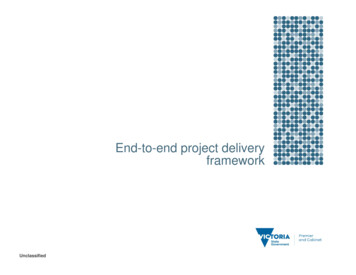
Transcription
End-to-end project deliveryframeworkUnclassified
UNCLASSIFIEDIntroductionThis document outlines end-to-end project mechanisms, including key activities,stage gates, templates, governance, and tools for monitoring and controls.The project delivery framework is aligned to DTF’s investment lifecycle and highvalue/ high-risk guidelines. The governance framework is aligned to the ICTGovernance Education Program.Unclassified
UNCLASSIFIEDPurposeTo enhance delivery of information and communicationstechnology (ICT) projects across government by:– Providing reusable tools and templates, repeatable processes andimplementing a consistent management approach for project delivery.– Improving oversight and visibility of projects by ensuring information ispresented consistently, enhancing decision-making, reducing risks andincreasing confidence in project delivery.– Defining key stakeholders’ roles and responsibilities in relation to the project,including when and how they will be engaged.Unclassified
Framework components Activities – During each of the project stages, there are a set of activities that have tobe performed. For ease of display, these have not been reflected in a sequentialmanner but have instead been grouped. Stage gates – At the end of each stage, the project must go through a check point(gate) before continuing. The gate can be governed by the project board, steeringcommittee or the executive and ensures the project is ready to proceed to the nextstage. Project management templates – As an output of the activities performed duringeach stage. These templates are used as tools for communication with projectstakeholders. Note: these templates do not cover project-specific outputs such asstrategies, policy, etc. Governance – Project governance is required to ensure the project is delivering itsintended objectives and achieving the anticipated outcomes and benefits. This sectionprovides governance principles, a structure, roles and descriptions. Monitoring and controls tools – A successful project has appropriate tools in place tomonitor and control the progress of the project. This section outlines the tools requiredfor project monitoring and controls.Unclassified
T GOVERNMENTPRIORITIES & DIRECTIONConsider portfolio wideand WoVG investment1CONCEPTUALISEConfirm the needStageGates2PROVERecommend aninvestment3PROCUREAward a contractG2G1G34IMPLEMENTDeliver thesolutionG45REALISEDeliver thebenefitsG6G5Activities grouped byLifecycle StageScope Project EvaluationPrepare RFTDeliverGo to MarketConduct ResearchDesignAssess PriorityCharacterise ProblemClassifyDefine BenefitsAllocate to BranchAssess OptionDetermine EvaluationApproachBuildTestAnalyse Value‐for‐Money of options (e.g.Proof of Concept)Evaluate ResponsesNegotiate ContractManage Delivery(Controls)Build case for SolutionAward ContractManage StakeholdersArrows in the diagram represent a sequential flow from the last activity in a stage group to the first activity in the next stage group.UnclassifiedID Issues & FindingsCapture Lessons LearnedDetermine extent ofBenefits Delivery
UNCLASSIFIEDEnd-to-End Delivery Framework- StageStage gatesGates for IMLSTAGE1 - CONCEPTUALISEConfirm the needStage Gate assessments enable projects to progressto the next stage2 - PROVERecommend an investmentRESULTG2G1Gate 1Concept and FeasibilityGATE (G) #& NAMEEarly filtering3 - PROCUREAward a contractG34 - IMPLEMENTDeliver the solutionG45 - REALISEDeliver the benefitsG6G5Gate 2Full Business CaseGate 3Readiness for MarketGate 4Tender DecisionGate 5Readiness For ServiceGate 6Benefits RealisationFunding decisionTender RequestedContract awardedProject handoverBenefits materialisePURPOSETo investigate the strategic directionand concept development of theproposed investment against thewider agency, portfolio or whole-ofgovernment goals or needs.To investigate the business case andthe proposed way forward to confirmthe project is achievable and likely todeliver what is required.To investigateassumptions in thebusiness case andprocurement strategyproposed for the project.To investigate the business caseand the governancearrangements for the tenderdecision to confirm the project isstill required, affordable andachievable. The review alsochecks implementation plans arerobust.To investigate how ready theorganisation is to make thetransition from the specificationand/or solution toimplementation. It assessesthe capabilities of deliverypartners and service providersand confirms ownership of theproject is clearly identified afterhandover to operations.To confirm benefits set out inthe business case are beingachieved and the operationalservice or facility is runningsmoothly.DECISIONCONFIRMS- the policy merit is sound andevidence based;- options in response to the problemhave been sufficiently explored;and- the way forward is achievable.- stakeholders approve the intendedbenefits from the project;- the link with program andorganisational objectives is clear;and- the optimum balance of cost,benefits and risk has beenidentified.- details of the sourcingoptions, proposedprocurement route andsupporting information.- implementation plansare in place.- that the recommended tenderdecision is appropriate beforethe contract is awarded to asupplier / partner, or the workorder is placed with existingsupplier or other deliverypartner.- that sound processes are usedto select a supplier.- The process has beenwell managed;- business needs are met;- whether client and suppliercan implement and managethe proposed solution;- whether a successful outcomecan be achieved.- whether the solution isrobust beforeimplementation;- how prepared theorganisation is to implementthe business changes beforeand after delivery;- the contract managementarrangements; and- whether there is a basis forevaluating ongoingperformance. (contractmanagement phase.)- First review – concentrateson the business case andhow well arrangementshave been set up forservice delivery andassociated contractmanagement.- Mid term Review - examinesaspects such as contractmanagement, improvementsin value-for-money andperformance incentivesagainst the baseline.- Final Review - looks atactivities relating to theclosure of the current servicecontract and ensuringsuitable arrangements are inplace for the future.KEY OUTPUT------for assessmentStrategic assessment (non-HVHR)Preliminary Business Case (HVHR)Full Business caseUNCLASSIFIEDExpressionsof InterestRequest for tenderProject status reportsExpressions of InterestRequest for tenderProject status reportsProject status reportsProject status reportsBenefits realisation reportPage 7
UNCLASSIFIEDProject management templates foreach activityInvestmentLifecycleStages0 - SET GOVERNMENTPRIORITIES &DIRECTIONConsider portfolio wideand WoVG investment1CONCEPTUALISEConfirm the needStage GatesTEMPLATESTASK /ACTION-Project sizingspreadsheet-As above-TEMPLATESHVHR /LARGEPROJECTAs aboveEstablish project governance· Appoint Action Lead· Determine OwnerAllocate fundingEstablish project governance(PCB)Idea Brief (N/A Large/HVHR)includes:· Scope Statement· Funding/ Cost Benefits· ID key stakeholders· Timescale (incl. high levelschedule)Register Project with PMO bysubmitting briefStrategic assessment (nonHVHR)As above PLUS- Create project controls *- High level Schedule (MSP)- Status Report- Preliminary Business Case(HVHR)3PROCUREAward a contractG2G1TEMPLATESSMALL &MEDIUMPROJECT2PROVERecommend aninvestmentG3-Status Report (ICT Actions Register)Create Lessons Learned Register-Full Business CasePIDStakeholder Engagement(Communication) PlanCreate project controls *Detailed ScheduleStatus ReportCreate BenefitsRealisation Plan (BRP)Stage Plan (N/A Small)-As above PLUS- Change ManagementPlan-Update projectcontrols *Update ScheduleStatus ReportExpressions ofInterest (EOI)Request for tender(RFT)ContractStage Plan (N/ASmall)As above4IMPLEMENTDeliver thesolutionG4G5-Refine Business CaseUpdate project controls *Status ReportUpdate BenefitsRealisation PlanTransition(Implementation) PlanOperational ReadinessReviewStage Plan (N/A Small)As above* NOTE PROJECT CONTROLS include Registers for Risks, Issues & Changes, Dependencies, Actions, Decisions,Financials and Lesson Learned. Each Register is a separate tab/sheet in the Control Workbook templateUnclassified5REALISEDeliver thebenefitsG6-Close Lessons Learned-Close project controls *Post ImplementationReview workshop· Lessons Learned· Follow on Actions /RecommendationsBenefits Realisationreport-As above PLUS- Post ImplementationReview includes detailedinterviews conducted byindependent party
UNCLASSIFIEDProcess from idea to projectInvestmentLifecycleStages0 SET GOVERNMENTPRIORITIES & DIRECTIONExecutive / PortfolioGovernance GroupIDEA1 CONCEPTUALISEConfirm the needProjectManagerPMO(receives Idea Brief &allocates Projects ID)Stage Gate2 PROVERecommend an InvestmentG1PortfolioGovernanceGroup (reviews)Go /No GoYesActivities grouped byLifecycle StageNoConduct ResearchCharacterise ProblemAnalyse Value‐for‐Money of optionsAssess OptionBuild case for SolutionClassifyAllocate to branchDefine BenefitsYesTemplatesSTOPAccess PriorityProject SizingSpreadsheetPreliminaryBusiness CaseLarge/HVHR?NoIdea Brief(Send to PMO)See full list of templates on End‐to‐End Delivery Framework – Project Management TemplatesUnclassified
UNCLASSIFIEDGovernance: principlesPrincipleApplicationAccountability There should be a single point of accountability for the project (i.e. the project sponsor)Their accountability is for the realisation of project benefits.Accountability cannot be delegated.Role clarity Members of the project board should understand and be clear on their role.Members of a project board should be clear that their primary concern – and loyalty – is to ensurea successful outcome from the project.Project board members should also clearly define the roles for others, such as the project manager. Authority The project sponsor must have sufficient authority (within the organisation) to effectivelydischarge accountability to the project.Transparency Decisions made regarding ICT‐enabled projects should be communicated to stakeholders in atimely and comprehensive manner.Commitment Prospective members should ensure they have time to govern the project before committing tomembership of a project board.A governance structure that adheres to these principles requires a mandatory project control board (PCB).Programmes, high‐value/high‐risk (HVHR) projects or projects spanning multiple departments or agencies may require asteering committee in addition to a PCB. Stakeholders should be informed about ICT‐enabled projects in a timely andcomprehensive manner.Unclassified
UNCLASSIFIEDGovernance: structureThis governance structure is based on PRINCE2 and ICT Governance Education Program Learning Resource v2.0.(Advisory)Governing BodySteering CommitteeChairAdvisory: MembersProject Board(Accountable)SponsorSystem OwnerSenior SupplierSenior UserProject Management TeamProject ManagerUnclassifiedChange ManagerTechnical LeadSupplierContent Contributors2nd tier forlarge/complexprojectsProject OfficerUser or User GroupMandatoryGoverning Bodylevel (1st tier)
UNCLASSIFIEDGovernance: roles and descriptionRoleDescriptionProject Sponsor The executive (also known as the project sponsor or customer or project owner) leads the project board, is the ultimatedecision‐maker, ensures that that project meets its intended objectives, and is ultimately accountable for project success. The person paying for the project. Appoints people to the roles of senior user and senior supplier. Chairs meetings and conducts briefings. Monitors progress and any changes to the project plan. Also a member of the project board.Senior Supplier Responsible for ensuring that the best solution is adopted to deliver the project and that the integrity of the solution ismaintained, so that the project is capable of delivering its intended benefits.Senior User Responsible for representing and specifying the needs of those who will use the end result of the project, and monitoringthe project to ensure that these needs are met (within the constraints of the business case);ProjectAssuranceProject assurance involves monitoring all aspects of a project’s performance, including the quality of deliverables. It mayinclude ensuring that:UNCLASSIFIED risks are controlled; correct process and procedures are being followed; project scope changes are not going unnoticed; internal and external communications are effective; and the solution being developed meets business requirements.Project board members may carry out project assurance if they have the time, skills and experience. It can be delegated toindividuals who then report to the board, including those external to the project and the organisation undertaking the project.Because the project assurance function provides ongoing oversight of the project, the project manager and the supplier(s), itis not appropriate to delegate project assurance to the project manager or to a vendor account manager. Those withresponsibility for this function should be selected by and answerable to project board members.Unclassified
UNCLASSIFIEDGovernance: roles and descriptions (ctn’d)RoleDescriptionProject Manager SupplierWorks on behalf of the project board to manage the project to agreed specifications and tolerancesSelects project team membersIs responsible for making sure work is performed within tolerancesPrepares project plansKeeps the project board informed of progress, and highlights any current or emerging problemsThe project manager is the manager of the project team, and reports to the project board.The role of the project manager in relation to the project team is to determine what work needs to be done, in what order, and how,to deliver the project outcomes. They also manage the allocation of project resources, including finances and staff, and contractsassociated with the project. The person or team who will do the work or deliver the project.User The person who is going to use the results or outcome of the project, or who will be impacted by the outcome.Technical Lead(Undefined in the training material)Change ManagerThe role of the change manager will vary from project to project, depending on the scope of change required. In general, the change managerwill: establish and specify the extent of change required; lead change (to business processes, work practices, organisational structure, training, communications, roles and responsibilities, etc.) toensure the realisation of business benefits; and evaluate the extent to which business change activities have contributed to the realisation of business benefits.Depending on the scale and complexity of the project, the project management tasks might be undertaken by staff working withthe project manager. Typically, these staff undertake specific sets of project management tasks – such as: business case preparation, financial management, contract management, communications – and they need to have capabilities relevant tothese tasks. Sometimes project officers are fully engaged in the project, however, the project will often be just one of a number of activities in whichthey are involved at the same time.Project OfficersContent Contributors UnclassifiedThese members of the team are responsible for creating specific content – in the case of ICT this might be:the development or modification of certain software solutions,the development or refinement of a software interface,the transference of data from one system to another,developing and implementing change actions, including developing new work processes and training stakeholders about how to use a newsystem.
UNCLASSIFIEDMonitoring & controls: principles The controls should be developed tobe fit for purpose. The controls should be adding value – notbe seen as unnecessary work. Project controls will focus on providingvisibility and accountability, andupholding quality as well as effectivedelivery. The PMO will be a central point ofcontact and the ‘point of truth’ forproject management, tools, templatesand processes. The PMO will be responsive tostakeholder feedback for continuousimprovement.Unclassified
UNCLASSIFIEDMonitoring & control:tools requiredProject sizing spreadsheetIdea briefProject board terms of referenceProject initiation documentScheduleStakeholder engagement planChange management planBenefits realisation planStage planWorkbook‐ Risk and issue/change management‐ Dependency register‐ Decision register‐ Lessons learned register Project status report Post implementation review Unclassified
UNCLASSIFIEDMonitoring & control:project sizing spreadsheetWhenSet DirectionApplicable activityConceptualiseProveProcureImplementRealise Project Type RequiredTaskSmallMediumHV/HR*Optional The purpose of the project sizing spread sheet is to use high‐level descriptions of a piece of workand decision factors to provide guidance about the size of a project and the level of documentationand detail required for varying sizes of projects.Example:Unclassified
UNCLASSIFIEDMonitoring & control: idea briefWhenApplicable PhasesSet DirectionConceptualiseProveProcureSmallMediumHV/HR ImplementRealise Project Type Required*OptionalTaskThe purpose of the idea brief is to provide a level of understanding of project time and cost in orderto decide whether the project executive should: Proceed with the investment without further analysis, or Invest the time and effort required to produce a full business case.This document brings together (at a high level) what is known and what has been assumed in orderto produce initial estimates.The idea brief will also outline the project’s intended: Governance (see section on governance) Stakeholder engagement approach Quality management planUnclassified
UNCLASSIFIEDMonitoring & control:project board terms of referenceWhenApplicable PhasesSet DirectionConceptualiseProveProcureImplement SmallMediumHV/HR RealiseProject Type Required*OptionalTaskThe purpose of the project board terms of reference is to describe the role and responsibilities of theproject control board or steering committee, which is responsible for ensuring: the project meets its objectives and the board’s requirements Project milestones are achieved and stakeholders are satisfactorily consulted and kept informed offuture changes.The project manager is responsible for ensuring all relevant and necessary issues are included inthe terms of reference.Unclassified
UNCLASSIFIEDMonitoring & control:project initiation document (PID)WhenApplicable PhasesSet DirectionConceptualiseProveProcureImplement SmallMediumHV/HR RealiseProject Type Required*OptionalTaskThe purpose of the PID is to provide the project information required for senior managementand stakeholders to commit to the resources and timelines proposed. It is a sort of ‘contract’between the project manager and project sponsor/project board that defines how the projectwill be run.A PID will include: a detailed proposition against which success can be measured; how the project will be developed and when it will be delivered based on the approved idea brief;and a detailed understanding of the costs and benefits of the project and, in particular, the resources,risks and timelines required for successful delivery.Unclassified
UNCLASSIFIEDMonitoring & control: scheduleWhenApplicable PhasesSet DirectionConceptualiseProveProcureImplement SmallMediumHV/HR RealiseProject Type Required*OptionalTaskThe purpose of the project schedule is to allow the project manager to plan for tasks, time andresources required to deliver the project. The following questions should be considered: Does your scheduling allow for weekends, public holidays and other non‐working days? Will the resources/skills be available in sufficient quantities when you need them? Are there any internal and/or external stakeholder tasks/events that coincide with the projectand limit the availability of resources? Are any individuals scheduled to work on other projects when you need them? Will any individuals or skill/types be overloaded with project work at any time? Have you adjusted the timing and allocation of work to spread the load evenly? Can you meet your time constraints/target delivery dates? Do you need to include recruitment, procurement, training or induction activities?Unclassified
UNCLASSIFIEDMonitoring & control:stakeholder engagement planWhenApplicable PhasesSet DirectionConceptualiseProveProcureImplement SmallMediumHV/HR RealiseProject Type Required*OptionalTaskTools & Artefacts: insert template name The purpose of the stakeholder engagement plan is to outline the engagement approach to ensurekey stakeholders buy‐in through the project life. The scale of change caused by the project willdetermine how this plan should be developed. If the change scale is small, a simple table in the PID canbe used. If the change scale is medium/large, it is suggested that a separate plan is used to capture thisinformation.The plan will include: Stakeholder identification and analysis (who, their needs, and how the project will impact them) Engagement approach (time, resources, channels) to ensure stakeholder involvement andminimise change impacts. For example, business reference groups (if appropriate), workshops withsubject matter expert to design the future or analyse the change, and one‐on‐one briefings withsenior stakeholders.Unclassified
UNCLASSIFIEDMonitoring & Control- Change Management PlanWhenApplicable PhasesSet DirectionConceptualiseProveProcureImplement SmallMediumHV/HR RealiseProject Type Required*OptionalTaskThe purpose of the change management plan is to provide specific details, including actions, timelines,dates and the allocation of responsibility, required to effectively manage project change from inceptionto delivery. It aims to capture a complete and holistic view of various planning components of thechange. The intended audience is the project manager, project team, project sponsor and any seniorleaders whose support is needed to carry out the plan.The scale of change will determine how this information should be captured. If change scale is small,the change approach can be described in the PID. If the change scale is medium/large, it is suggestedthat a separate change management plan is used to capture this information.Unclassified
UNCLASSIFIEDMonitoring & control:benefits realisation planWhenApplicable PhasesSet DirectionConceptualiseProveProcureImplement SmallMediumHV/HR Realise (report)Project Type Required*OptionalTaskThe purpose of the benefits realisation plan is to provide details of how the benefits managementprocess will be applied to a project. It describes the tasks, resources, time frame and approach tobenefits management.The plan will describe: Benefits ownership Benefits activity plan Baseline measures Post go‐live benefits tracking frameworkUnclassified
UNCLASSIFIEDMonitoring & control:stage planWhenApplicable PhasesSet DirectionConceptualiseProveProcureImplement SmallMediumHV/HR RealiseProject Type Required*OptionalTaskThe purpose of the stage plan is to design the work up to the point where the project sponsor/projectboard should: review achievements to date and assess project viability take key decisions outside the level of authority of the project manager approve a more detailed plan for the next stage of work commit resources in accordance with the project or stage plan assess the impact of some significant external event that will influence the project (e.g.: legislation,decision point in other project, review of business operation).The detailed plan for a stage will be produced towards the end of the preceding stage, when theinformation needed for planning is available.Unclassified
UNCLASSIFIEDMonitoring & control:risk & issue/change managementWhenApplicable PhasesSet DirectionConceptualiseProveProcureImplement SmallMediumHV/HR RealiseProject Type Required*OptionalTaskThe risk and issues/change management tool is a central register that records risks, issues and required changes thatimpact on a project/program’s scope, schedule and budget.A project manager is required to review the risk and issues/change management register to ensure appropriatemanagement and controls are in place for these registered risks/issues/required changes. The project manager alsoneeds to report these risks/issues/changes in the project status report to ensure project sponsor/projectboard/project team and other senior stakeholders are aware of the project challenges and that necessary actions havebeen undertaken to mitigate them.A risk is any area of uncertainty that represents a threat or an opportunity to the project. To manage and mitigaterisks, the project manager needs to identify risks, assess the likelihood of risks happening and estimate the impactthese risks might have on the project.An issue is a risk that has materialised or an unplanned event that (unless action is taken) will impact the projectscope, cost, quality or schedule. A project change may be a result of a specific issue.Unclassified
UNCLASSIFIEDMonitoring & control:dependency managementWhenApplicable PhasesSet DirectionConceptualiseProveProcureImplement SmallMediumHV/HR RealiseProject Type Required*OptionalTaskThe purpose of the dependency management tool is to provide a project’s central register of alldependencies.A dependency describes where successful performance of an activity (or set of activities) is reliant onthe actions of a third party. The third party actions will be outside the immediate project schedule, i.e.they may be within or across a branch/division, or external to the portfolio of projects and programmes.Managing project dependencies and reporting them in the regular project status report helps a projectmanager to monitor project progress and take remedial actions if necessary.Unclassified
UNCLASSIFIEDMonitoring & control:decision registerWhenApplicable PhasesSet DirectionConceptualiseProveProcureImplement SmallMediumHV/HR RealiseProject Type Required*OptionalTaskA decision register is a central register used for recording key project decisions, justifications andactions so that it is easy to review what was agreed and when.Decisions can be reviewed and reversed or changed if necessary as long as the history andjustification for the change (and approval record) is logged.For example, a decision register may provide clarity when the project team is working on a projectthat involves changes to strategy or approach, or has a long duration.Unclassified
UNCLASSIFIEDMonitoring & control:lessons-learned registerWhenSet DirectionConceptualiseProveProcureApplicable PhasesImplementRealise Project Type RequiredTaskSmallMediumHV/HR*Optional The purpose of a lessons‐learned register is for a project team to share knowledge gained fromproject delivery. A successful lessons‐learned program will help project teams to repeat desirableoutcomes and avoid undesirable outcomes so the entire organisation may benefit.The lessons‐learned register is intended to be used throughout the project lifecycle to collectinformation that has been obtained during any phase of the project. Project staff performingdifferent functions on the project will have a different outlook on successes, failures, and possiblesolutions.Unclassified
UNCLASSIFIEDMonitoring & control:project status reportWhenApplicable PhasesSet DirectionConceptualiseProveProcureImplement SmallMediumHV/HR RealiseProject Type Required*OptionalTaskStatus reporting is a key element of the project monitoring and control process.Its purpose is to ensure that the objectives of the project are met, and variances fromthe plan are identified by monitoring and measuring progress regularly. When variancesare identified, corrective action can be taken.Status reporting also communicates project status to stakeholders and keeps theminformed of the critical project controls including schedule, cost, budget, scope/qualityof risks, issues and changes.Unclassified
UNCLASSIFIEDMonitoring & control:post implementation reviewWhenSet DirectionConceptualiseProveProcureApplicable PhasesImplementRealise Project Type Required*OptionalTaskSmallMediumHV/HR The purpose of the post implementation review is to: evaluate the efficiency and effectiveness of the project in meeting the stakeholder requirements. identify improvements and key success factors that can be applied to future projects.The content of this report is input provided by the Project Manager and all key members of theproject team. It can be done through a questionnaire and a Post Implementation Review workshop.The review of the project should be conducted by appointing a qualified person or a project managerwho is independent to the project. Where this is not possible, the project manager will conduct thisreview.Unclassified
E2E framework for agile productsUnclassified
UNCLASSIFIEDEnd-to-end framework for agile projects1 CONCEPTUALISEConfirm the need0InvestmentSET GOVERNMENTLifecyclePRIORITIES & DIRECTIONStages3 PROCUREConfirm the needAward a contract2 PROVERecommend an Investment4 IMPLEMENTDeliver the solution5 REALISEDeliver the BenefitsMeasure BenefitsScope ReviewDeliverAnalyse Value‐for‐Money ofoptionsBuild case for SolutionAssess OptionDefine BenefitsCharacterise ProblemConduct ResearchAllocate to BranchClassifyMVP & additionalfeatures fromproduct backlogAssess PriorityLifecycle ActivitiesMVPPrepare RFTGo to MarketEvaluate ResponsesNegotiate ContractAward ContractCapture Lessons Learnt(retrospectives)Manage Delivery (Controls)Manage StakeholdersKey: patterned rectangles are those activities that happen in ‘Realise’ for non‐agile projectsUnclassifiedID Issues & Findi
Project management templates for each activity Investment Lifecycle Stages G1 G2 G3 G4 G5 G6 * NOTEPROJECT CONTROLS include Registers for Risks, Issues & Changes, Dependencies, Actions, Decisions, Financials and Lesson Learned. Each Register is a separate tab/sheet in t



